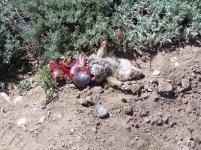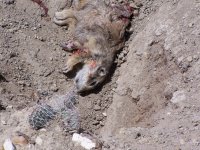I have been reloading since 1974, and shooting prairie dogs since 1982. One pleasant morning I fired 23 rounds of 25-06 (17¢ each, range 225 yards) until the dog got bored and went down the hole. The next shot at a different dog was successful.
Later, on that same trip I hit 27 consecutive dogs at 150 yards to 200 yards with my XP-100 in 223 Rem.
I understand the important concept of "Zero Your Rifle Scope" with the ammo you are going to shoot. I did that. On June 23, I missed 65 consecutive shots on several prairie dogs at 110 to 200 yards. In frustration, I rezeroed my scope (was 4" right at 200 yards) on a rock that did not move. During that steady stream of lead, 1 shot was perfect for windage, but 3" high for elevation. The bullet kicked up dirt on the mound behind the dog. The ground was wet from rain, no dust puffs, no dirt clods, nothing!
After rezeroing the scope, I hit 2 dogs with the last 10 rounds of that ammo. I had a different batch of ammo, cleaned the rifle (a rebarreled S&W M1500 in 223), a resumed shooting. My hits were about 75% with the different ammo lot and no scope changes.
I need to reload to reduce shooting costs. I switched to my AR-15. It shot like a lazer with 90% hits at random ranges.
While this insanity was going on, my shooting partner drove around another part of the field hitting 120 dogs with his stock Ruger 1022 heavy barrel 22 LR rifle using the outside mirror for a steady rest.
Later, on that same trip I hit 27 consecutive dogs at 150 yards to 200 yards with my XP-100 in 223 Rem.
I understand the important concept of "Zero Your Rifle Scope" with the ammo you are going to shoot. I did that. On June 23, I missed 65 consecutive shots on several prairie dogs at 110 to 200 yards. In frustration, I rezeroed my scope (was 4" right at 200 yards) on a rock that did not move. During that steady stream of lead, 1 shot was perfect for windage, but 3" high for elevation. The bullet kicked up dirt on the mound behind the dog. The ground was wet from rain, no dust puffs, no dirt clods, nothing!
After rezeroing the scope, I hit 2 dogs with the last 10 rounds of that ammo. I had a different batch of ammo, cleaned the rifle (a rebarreled S&W M1500 in 223), a resumed shooting. My hits were about 75% with the different ammo lot and no scope changes.
I need to reload to reduce shooting costs. I switched to my AR-15. It shot like a lazer with 90% hits at random ranges.
While this insanity was going on, my shooting partner drove around another part of the field hitting 120 dogs with his stock Ruger 1022 heavy barrel 22 LR rifle using the outside mirror for a steady rest.
Attachments
Last edited:





